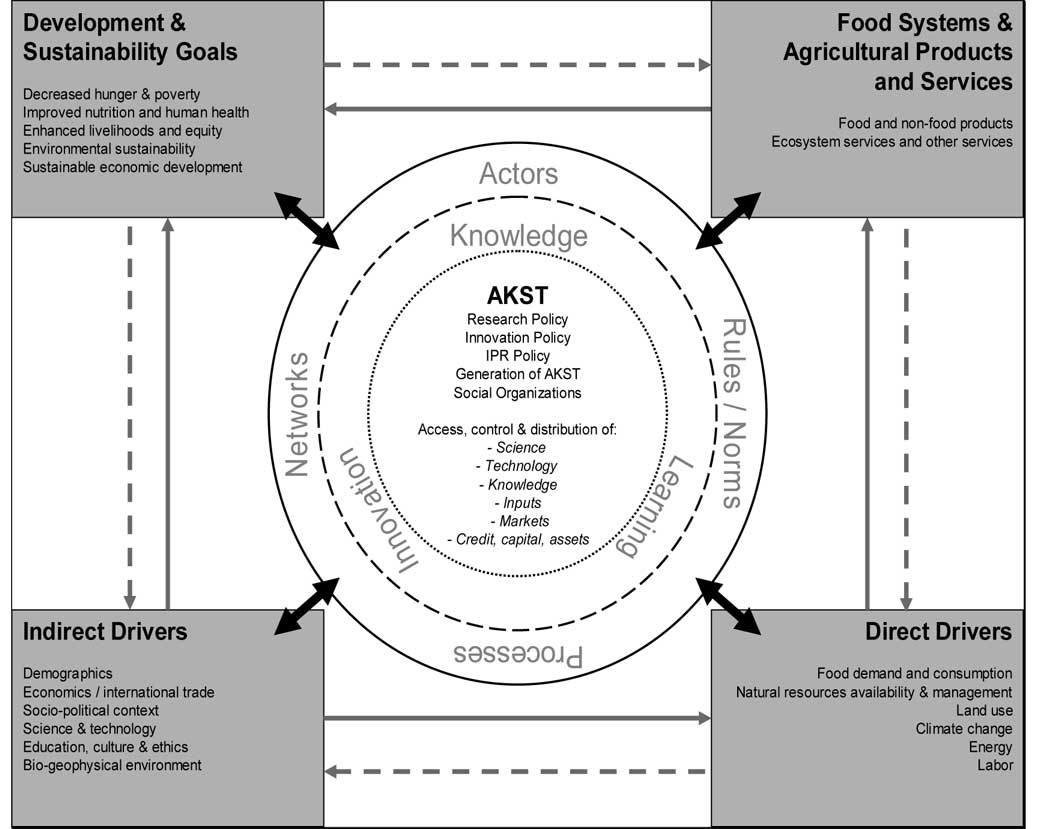
| Previous | Return to table of contents | Search Reports | Next |
| « Back to weltagrarbericht.de | ||
Indicators | 13

Figure 1-7. Conceptual framework of the IAASTD.
|
of research and development (R&D). As a practical contemporary example, this debate is very much at the heart of current discussions about how agricultural research should be conducted in all countries. Innovation and innovation systems. Scientific and technological knowledge and information can (1) add value to resources, skills, knowledge, and processes, and (2) create entirely novel strategies, processes, and products (World Bank, 2006a). An innovation system may be defined as the network of agents, usually organized in an interdisciplinary and transdisciplinary manner, with interactions that determine the innovative impact of knowledge interventions, including those associated with scientific research. The concept is now used as a kind of shorthand for the network of interorganizational linkages that apparently successful countries have developed as a support system for economic production. In this sense it has been explicitly recognized that economic creativity actually relies on the quality of "technology linkages" and "knowledge flows" amongst and between economic agents. Where interactions are dynamic and progressive, great innovative strides are often made. Conversely, where systemic components are compartmentalized and isolated from each other, the result is often that relevant research bodies are not innovative. Some approaches suggest that innovation systems cannot be separated from the social, political and cultural context from |
which they emerge (Engel, 1997), and this context therefore has to be included in the analysis of AKST. This implies a need to focus on those factors that enable the emergence of "innovative potential," rather than on factors related directly to specific innovations. Collaborative learning processes. The creation of favorable conditions making it possible for different actors to engage in collaborative learning processes-i.e., the increase in space and capacity for innovativeness-has thus gained prime importance. Approaches based on linear understandings of research-to-extension-to-application are being replaced by approaches focusing on processes of communication, mutual deliberation, and iterative collective learning and action (van de Fliert, 2003). More concretely, this implies that sustainable use of natural resources requires a shift from a focus on technological and organizational innovation to a focus on the norms, rules and values under which such innovation takes place (Rist et al., 2006). The enhanced AKST model considers that values, rules and norms that are relevant to the promotion of agricultural development are constantly produced and reproduced by social actors who are embedded in the social networks and organizations to which they belong. Social networks are important spaces where the actors involved in the coproduction of knowledge share, exchange, compare and eventually socialize their individually realized perceptions of what is important, good, |
| Previous | Return to table of contents | Search Reports | Next |
| « Back to weltagrarbericht.de | ||